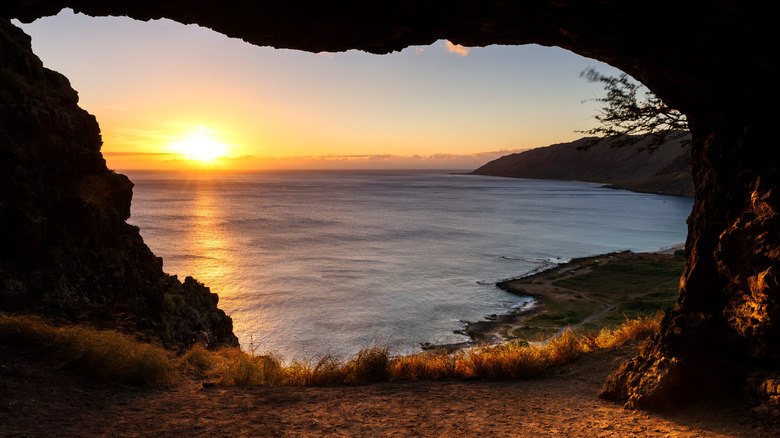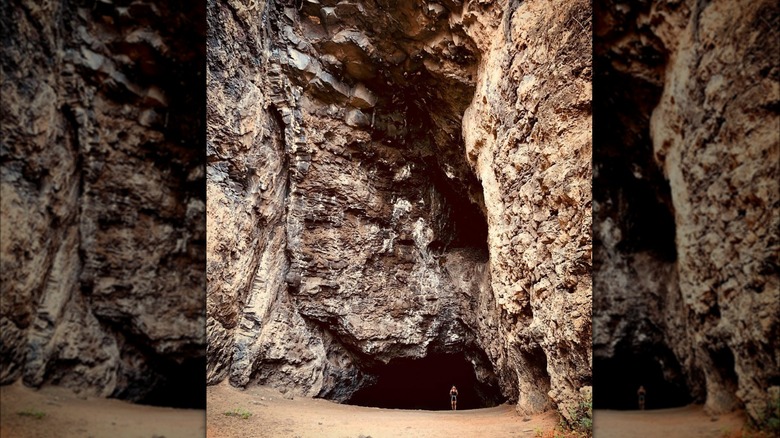Hawaii's Supposedly Haunted And Often Overlooked Cave Offers A Beautifully Mysterious Adventure
Throw a dart at a map of Oahu, and chances are it will land somewhere that offers an amazing experience with a fascinating story. Whether it pierces the Polynesian Cultural Center or points you toward the Pearl Harbor National Memorial, there's plenty of history and culture among the various attractions. That rule extends to other icons of The Gathering Place, like Iolani Palace and the Ala Moana Center, which are crucial spots that all visitors and locals alike should experience at least once in their lives. Among these well-known treasures, though, are hidden gems that few will recognize, such as Kaneana Cave.
If you've never been to Hawaii, you'll quickly realize just how important the local culture and history is to its people. Many of the stories that grace sights like Kaneana Cave (or Makua Cave) have some connection to the island's old gods. The towering cave, for instance, has ties to Kamohoali'i, the shapeshifter shark god who held dominion over the toothed sea life. While Kamohoali'i's connection to the cave is grizzly, the natural formation itself is beautiful, a stark contrast to the haunting and bloodied legend of the shark god and his child, Nanaue.
Local legend states that the shark god wasn't the only unusual history imprinted on the slick walls of the cave. If you do brave the massive 100-foot tall, 450-foot deep cave, don't be surprised if you happen upon ethereal entities and feel the powerful presence of former chiefs who once guided the island's people.
What are the legends of Kaneana Cave?
As you explore the majestic Oahu cave, you'll want to keep your eyes peeled for a pair of red eyes glowing in the darkness or listen for priests (or kahuna) performing a ritual to appease an unseen force. There are many stories told of Kaneana Cave. Some locals believe it's a portal to hell, and others believe it houses the souls of chiefs who have died over the years. It's even thought to have been the burial site of a young girl murdered sometime in the early 20th century.
The most famous legend attached to the cave follows the previously mentioned Kamohoali'i, a shark god, and his son, Nanaue. According to the legend, Kamohoali'i sired a child with a woman named Kalei. At his birth, the child looked human, save for a vicious mouth on his back. Kamohoali'i warned Kalei never to let his mouth be seen by people and to keep him from getting a taste of human flesh. Though Kalei covered her son's back to hide his shark mouth, his identity couldn't remain hidden forever.
After Nanaue killed his first human prey, it became part of his nature, regularly dragging his victims to the slippery rocks of Kaneana to eat. He did survive into adulthood, having spent much of his life terrorizing the waters. One day, while working in a taro patch, another worker ripped off Nanaue's coverings, exposing his shark mouth. Nanaue tried to escape but was eventually caught and killed.
Can you walk through Kaneana Cave?
Though the mythical history of Kaneana Cave is quite dark, it is inviting to curious travelers who may want to explore a haunted relic of Hawaii's past. The problem, though, is that Kaneana Cave sits on the Makua Military Reservation. While accessible via the public Farrington Highway, the cave is at the very southeastern edge of the reservation. It seems to be a little-known fact that hasn't stopped many from making the trip out to the cave, but it is worth mentioning that exploring the 150,000-year-old formation can come with a fine.
There's also the issue that native Hawaiians are very protective of anything that may have been a ritual site. As one belief is that the cave was used for rituals performed by kahuna, it may be deemed disrespectful to enter the cave despite no physical signs of ritualistic practices. Since the islands are such a delicate ecosystem, respecting the grounds doubles as not inadvertently leaving your potentially damaging imprint on the rock formation.
If you are still insisting on walking through the expansive opening, moving safely is the key to a memorable visit. The cave isn't maintained or managed by anyone, and the smooth rock that's the product of years of water carving out access to a nearby lava tube can be dangerous to walk on. Since there's no defined walking path, you'll want to avoid narrow pockets and stick to the larger openings, bring a flashlight, and sturdy shoes with grip.


